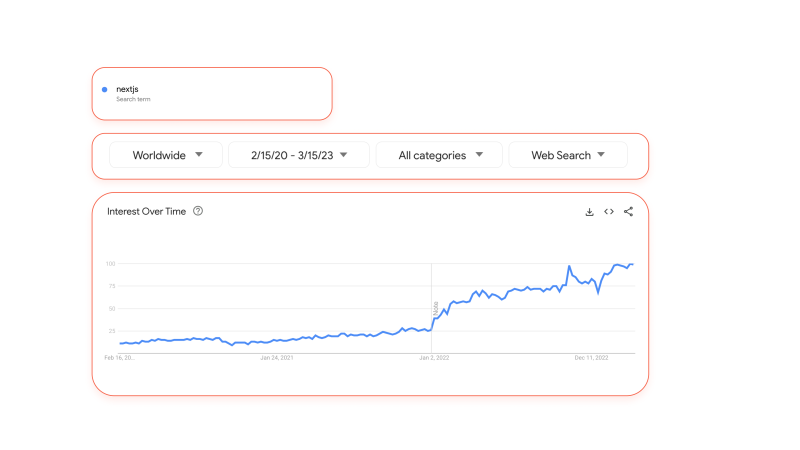/ Blog
10 Reasons We Use Next.js for Headless Commerce
Shruti Agarwal
Content Marketer
- DATE PUBLISHED (23/2/2023)
- READ TIME (5MIN)
For the uninitiated, Next.js is a framework that allows you to develop complete web applications. It uses the newest React functionalities and incorporates Rust-based JavaScript tools to ensure faster builds.
Listen, we’re not just obsessed with Next.js (okay, maybe just a little bit) - but we’re bringing receipts.
The framework has gained significant adoption in the tech community (100k+ GitHub stars!), making it one of the most popular open-source projects on the platform. And according to Google Trends, interest in Next.js has grown significantly, with a 4x increase in search volume since 2020.

Popular platforms like Twitch, TikTok, Hulu, Nike, HBO Max, and Product Hunt have embraced Next.js, and an actively growing community suggests that it will gain more popularity in the coming years.
OTOH, e-commerce is moving to the Next level.
Couldn’t resist. On a related note, let’s talk about headless commerce.
In 2021, we wrote about why the hype around headless is real. The trend has picked up, and how!
Headless implementations reduce the time needed for changes from days/weeks to just a few hours, and the sheer flexibility that a headless architecture offers to brands is unprecedented.
Salesforce’s State of Commerce report shows that 77% of brands that use a headless architecture have greater agility [1]. With customer acquisition becoming increasingly tougher, personalization at scale is the need of the hour - and headless commerce enables just that.
But what’s the right framework for going headless?
Among React-based frameworks like Next.js and Hydrogen, and MVC frameworks like Angular, we chose Next.js for our initial headless projects, and here’s why.
10 reasons why we use Nextjs for headless commerce
Next.js is a perfect solution for D2C brands that want to build beautiful and branded storefronts.
1. Server-Side Rendering (SSR) & Static Site Generation (SSG)
With Next.js, we can build a hybrid app leveraging either Server-Side Rendering (SSR) and Static Site Generation (SSG). This helps us reduce page load times by up to 25%[2], improves SEO results, and helps us offer better accessibility for all users.
Why is SSR better for SEO? At the simplest level - the faster search engines can crawl and index your pages, the better your crawl budget will be - directly impacting your search engine friendliness.
Server Side Rendering and Static Site Generation can also optimize server costs by reducing the need for server resources to render pages on the fly. This is an added advantage for bigger marketplaces.
2. Incremental Static Regeneration (ISR)
Incremental Static Regeneration (ISR) is a modern approach and combines the speed of Static Site Generation and real-time updates of Server-Side Rendering. This lets us serve pre-built pages while updating content on-the-fly, with no site rebuilds needed.
Which means faster load times, better SEO, and improved scalability, along with content freshness, because our e-commerce stores can now keep their inventory and prices up-to-date.
Incremental Static Regeneration also offers better scalability than SSR, as it reduces the load on servers by serving static content. This is particularly important for e-commerce stores that may experience traffic spikes during promotions or holidays.
3. API Routes
Next.js helps us easily create API routes essential for building headless e-commerce experiences. These routes can fetch and update data and handle user authentication and authorization.
Custom Serverless Functions: Creating custom API endpoints using serverless functions. These endpoints can be used to perform backend tasks like processing orders, handling user authentication, or managing customer data.
Simplified Data Fetching: Fetching and managing data from multiple sources, like databases, third-party APIs, or headless CMS. This simplifies data handling and keeps the frontend code clean and organized.
Easy Integration: API routes make it easier to integrate an eCommerce store with external services like payment gateways, shipping providers, or email marketing tools. These routes let us communicate with these services without exposing sensitive information.
Improved Security: By handling sensitive tasks and data on the server-side, API routing in Next.js helps us keep the eCommerce experience more secure. This reduces the risk of exposing private information or credentials to potential attacks.
4. Customizable Routing
Next.js allows for customizable routing, making it easy to create cleaner and more contextual URLs. This simplifies complex navigation structures and makes dynamic routing easy.
This feature is particularly important for marketplaces with a bigger inventory. A study by Backlinko in 2020[3] showed that shorter URLs rank better in search results than longer URLs, so this makes customizable routing all the more important in helping marketers create shorter and more relevant links for product and category pages.

5. Image Optimization
This is a big one. Most eCommerce stores struggle with site speed, and it’s almost always because they’re asset heavy. Next.js provides in-built image-optimization. What does that mean?
Automatic Image Optimization: Optimizes images in modern formats like WebP, and compresses image sizes for faster page load times.
Improved Performance: The image component serves images based on the screen size, desired format, and resolution, minimizing the amount of data that needs to be transferred.
Visual Stability: Prevents Cumulative Layout Shift (CLS)[4] automatically, improving the user experience. This is because Next.js automatically inlines critical CSS into the HTML of the page, which reduces the impact of layout shifts caused by loading external stylesheets.
Asset Flexibility: On-demand image resizing is available for images stored on remote servers, providing greater asset flexibility.
Lazy Loading: Loads images only when they are actually needed, optimizing the data that needs to be transferred to a user's device and improving the overall UX.
6. Easy CMS Integration
Our marketing team loved this one.
Popular headless Content Management Systems (CMS) like Sanity, Contentful, and Strapi have Next.js starter templates and provide pre-built integrations. This makes building and managing content-driven websites super easy and quick.
Separating the content management and front-end components makes development and maintenance easier. By leveraging pre-built integrations and components, developers and marketers can integrate the CMS and create content on the go, minus the complications.
Some headless tools also come with drag-and-drop page builders for landing pages. This makes it possible for teams to run creative marketing campaigns without technical dependencies.
What I love about Next.js is that it helped us take the storefront experience to the next level with proxy APIs. This gave us a hassle-free way to create custom apps for small tasks. We could easily execute admin API calls and integrate features like order cancellation and order editing into our customers' accounts. It's all about providing unparalleled convenience and control. That's where Next.js wins.
Gopi Para, Founder - Coderapper
7: CSS-in-JS
Next.js supports several popular CSS-in-JS libraries like styled-components and CSS modules. These libraries allow developers to define styles using familiar CSS syntax, and create reusable and composable components that adhere to a design system.
CSS-in-JS offers a lot of benefits like:
Scoped Styles: Styles are applied only to specific components, not globally. This prevents style conflicts and reduces the risk of unintended consequences when modifying the CSS.
Dynamic Styling: Dynamic styles that respond to user input, browser events, or other factors. Used to create more immersive and interactive user interfaces.
Code Reusability: By defining styles using JS, developers can reuse code across different components, reducing duplication and simplifying the codebase.
This is a great way to build high-performance and responsive storefronts.
Also read: How Next.js helped Redsea simplify their design system
8. Theme Support
It’s easy to create and manage theme objects that define common design properties like color, typography, and spacing. This way, you can maintain consistency across your eCommerce store or application and manage a cohesive design system that offers a fully branded experience.
9. Component Library Support
Next.js integrates easily with popular component libraries like Material UI, Ant Design, and Chakra UI. These pre-designed and pre-built libraries provide customizable components to match the design system and speed up development. Many of these component libraries feature built-in accessibility, which makes it easier for developers to build stores that meet the needs of all users.
Pro Tip: Enabling accessibility is an important part of the design and development process, and the ADA prescribes stringent laws and guidelines for compliance [5]. We highly recommend consulting experts to audit your existing store to provide a seamless experience for every user.
Going headless allowed us to build personalized and interactive landing pages. Our pages had near-perfect Lighthouse scores in the high 80s, and we saw a median increase in conversions by about 25-30% across campaigns from earlier.
Ganesh Chandrashekar, Head of Marketing - Coderapper
10. Internationalization
If you’re not going global in 2023, you’re missing out!
Shopify’s growing focus on enabling Shopify Markets signals the trend towards brands expanding internationally, and Next.js supports internationalization pretty much out-of-the-box.
Next.js includes built-in support for i18n (internationalization) through the use of the next-i18next library. This library provides tools for managing translations and localizations in multiple languages, including support for plurals, dates, and currency formatting.
As we did, you can leverage these tools and APIs for translating content, detecting user languages, and seamlessly managing language switching. It’s easy to implement and makes maintaining multilingual websites an absolute breeze.
Ready to leverage the power of Next.js?
We told you we’re bringing receipts.
If you're planning to build headless solutions or applications for your e-commerce business, we can help you choose the right framework for your business needs. We love a challenge!
Our e-commerce solutions drive growth and deliver ROI for our clients.
If you’re looking for an e-commerce partner, let’s talk. No strings attached!
Email hello@coderapper.com or use our website to reach out!
Links
[3] https://backlinko.com/search-engine-ranking
[5] https://adasitecompliance.com/website-accessibility-legal-requirement/